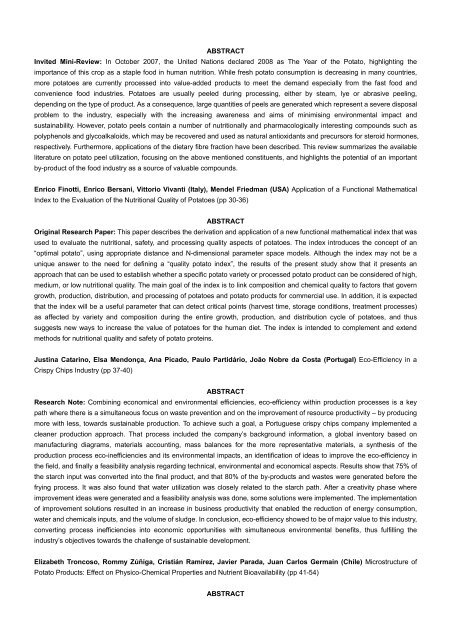Food - Global Science Books
Food - Global Science Books
Food - Global Science Books
Create successful ePaper yourself
Turn your PDF publications into a flip-book with our unique Google optimized e-Paper software.
ABSTRACT<br />
Invited Mini-Review: In October 2007, the United Nations declared 2008 as The Year of the Potato, highlighting the<br />
importance of this crop as a staple food in human nutrition. While fresh potato consumption is decreasing in many countries,<br />
more potatoes are currently processed into value-added products to meet the demand especially from the fast food and<br />
convenience food industries. Potatoes are usually peeled during processing, either by steam, lye or abrasive peeling,<br />
depending on the type of product. As a consequence, large quantities of peels are generated which represent a severe disposal<br />
problem to the industry, especially with the increasing awareness and aims of minimising environmental impact and<br />
sustainability. However, potato peels contain a number of nutritionally and pharmacologically interesting compounds such as<br />
polyphenols and glycoalkaloids, which may be recovered and used as natural antioxidants and precursors for steroid hormones,<br />
respectively. Furthermore, applications of the dietary fibre fraction have been described. This review summarizes the available<br />
literature on potato peel utilization, focusing on the above mentioned constituents, and highlights the potential of an important<br />
by-product of the food industry as a source of valuable compounds.<br />
Enrico Finotti, Enrico Bersani, Vittorio Vivanti (Italy), Mendel Friedman (USA) Application of a Functional Mathematical<br />
Index to the Evaluation of the Nutritional Quality of Potatoes (pp 30-36)<br />
ABSTRACT<br />
Original Research Paper: This paper describes the derivation and application of a new functional mathematical index that was<br />
used to evaluate the nutritional, safety, and processing quality aspects of potatoes. The index introduces the concept of an<br />
“optimal potato”, using appropriate distance and N-dimensional parameter space models. Although the index may not be a<br />
unique answer to the need for defining a “quality potato index”, the results of the present study show that it presents an<br />
approach that can be used to establish whether a specific potato variety or processed potato product can be considered of high,<br />
medium, or low nutritional quality. The main goal of the index is to link composition and chemical quality to factors that govern<br />
growth, production, distribution, and processing of potatoes and potato products for commercial use. In addition, it is expected<br />
that the index will be a useful parameter that can detect critical points (harvest time, storage conditions, treatment processes)<br />
as affected by variety and composition during the entire growth, production, and distribution cycle of potatoes, and thus<br />
suggests new ways to increase the value of potatoes for the human diet. The index is intended to complement and extend<br />
methods for nutritional quality and safety of potato proteins.<br />
Justina Catarino, Elsa Mendonça, Ana Picado, Paulo Partidário, João Nobre da Costa (Portugal) Eco-Efficiency in a<br />
Crispy Chips Industry (pp 37-40)<br />
ABSTRACT<br />
Research Note: Combining economical and environmental efficiencies, eco-efficiency within production processes is a key<br />
path where there is a simultaneous focus on waste prevention and on the improvement of resource productivity – by producing<br />
more with less, towards sustainable production. To achieve such a goal, a Portuguese crispy chips company implemented a<br />
cleaner production approach. That process included the company’s background information, a global inventory based on<br />
manufacturing diagrams, materials accounting, mass balances for the more representative materials, a synthesis of the<br />
production process eco-inefficiencies and its environmental impacts, an identification of ideas to improve the eco-efficiency in<br />
the field, and finally a feasibility analysis regarding technical, environmental and economical aspects. Results show that 75% of<br />
the starch input was converted into the final product, and that 80% of the by-products and wastes were generated before the<br />
frying process. It was also found that water utilization was closely related to the starch path. After a creativity phase where<br />
improvement ideas were generated and a feasibility analysis was done, some solutions were implemented. The implementation<br />
of improvement solutions resulted in an increase in business productivity that enabled the reduction of energy consumption,<br />
water and chemicals inputs, and the volume of sludge. In conclusion, eco-efficiency showed to be of major value to this industry,<br />
converting process inefficiencies into economic opportunities with simultaneous environmental benefits, thus fulfilling the<br />
industry’s objectives towards the challenge of sustainable development.<br />
Elizabeth Troncoso, Rommy Zúñiga, Cristián Ramírez, Javier Parada, Juan Carlos Germain (Chile) Microstructure of<br />
Potato Products: Effect on Physico-Chemical Properties and Nutrient Bioavailability (pp 41-54)<br />
ABSTRACT
















